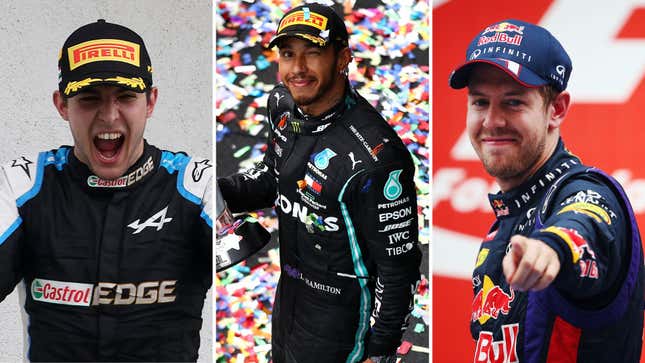How Formula 1 Racing Attracted a Ravenous New Community of Fangirls
Writer and Formula 1 expert Lily Herman discusses her new podcast, Carlos Sainz's jeans, and the pettiest dudes in motorsport.
EntertainmentTV

Before Netflix took a turn for the TERFs, the once-monopolistic streaming service had upped its budget to over $13.6 billion dollars, with a good chunk of that money now dedicated to unscripted programming. The content ran the gamut from mind-numbing and high cringe to shockingly delicious, with the likes of Too Hot to Handle, Tiger King, and Love Is Blind. Along with the rising tide of “lowbrow brilliant” series came a little show so campy and so melodramatic—with “carbon fiber death traps,” Russian oligarchs, Nigerian princes, men with baby Elvis swoon power, and a dream-crushing game of musical chairs—that it bore out a ravenous new community of fangirls no one saw coming. To just about everyone’s surprise, a star with a hell of a lot of horsepower was born out of a show about…race car drivers?
Accompanied by the zest of European men who can dress (thank fucking god), Formula 1: Drive to Survive is a show about the perils and pleasures of race car driving, the content of which isn’t entirely far off from what might be called The Real Housewives of the Monaco Grand Prix if it existed in the Bravo multiverse. As the series caught fire with young Americans and thirsty cougars like myself stuck at home in quarantine, so, too, did the world of motorsport, and along with it came a flood of appetite for content: Who of the drivers got in a tiff that week? Who would be the next to score a Valentino partnership? And, oh my god, did Kevin Magnussen really tell fellow driver Nico Hulkenberg to “suck my balls, mate?”
Luckily for us, Lily Herman, the co-host of the new podcast Choosing Sides: F1 from Sports Illustrated Studios and IHeartMedia is here to dish. The show, also hosted by Michael Kosta of The Daily Show, examines why a 70-year-old sport founded on a lingering hero complex and the boredom of WWII vets has attracted a thriving community of unexpected fans. Let’s unpack the sport’s scandals, rivalries, resentments, and daddy issues, shall we?
This conversation has been edited for length and clarity.

There’s a common scenario in sports in which women or nonbinary people might be interested in something like Formula 1, but feel it’s not marketed to them, nor was it created by people who look like them. What was it about F1 that kept you around?
Formula One really does offer something for everyone, even if it doesn’t try to. If you want the engineering or technical aspects, you can find that. If you care deeply about racing itself, you can find that. But a lot of sports, in general, require a great deal of pageantry and, quite frankly, a lot of camp. Formula One is no exception. I could tell you about Brawn GP becoming Mercedes or why the double diffuser is an important technological advancement. I could also tell you why I closely follow what Carlos Sainz’ denim choices were over the weekend. These things are equal to me in terms of importance. But we still hear that there’s a lot of gatekeeping from the old fans towards the newer Drive to Survive fans, and often, that means the exclusion of women, people of color, and LGBTQ+ folks, which spells more violent reactions and harassment of those newer fans.
In the podcast, you talk a lot about the influence of money in the sport and how difficult it is for these drivers to secure funding. Does it seem unfair to you that there’s such an onus on them to convince sponsors that funding them wouldn’t actually be a risk?
The classism of the sport comes across differently for every driver. If you’re looking at someone like Lewis Hamilton or Esteban Ocon, these are guys who had to fight all odds to make it into the sport. Ocon’s parents famously mortgaged their house and spent years living in an RV so he could kart, with his dad as the mechanic working on his car. I couldn’t imagine the sacrifice or even being aware at such a young age that your family is in some form of financial constraint because of this dream you have. Other drivers are called pay drivers, meaning they’re in the sport because they bring in significant sponsorship dollars, be it from a parent or another family member or from some major corporation. So, money absolutely plays this massive role and you can’t talk about any driver without explaining how they got there.
For context, take the sport of karting, which is where many of these drivers start out, as kids racing around local tracks. If you want to be competitive in karting, your parents are spending upwards of $100,000 a year. That’s already a major barrier to entry. On top of that, F1 is as much an engineering competition as it is a driving competition, which means there’s an onus for the teams to raise as much money as possible to build these incredible engineering feats, so they’ll want to bring in drivers with big sponsors. IndyCar in the U.S. costs hundreds of thousands to a million dollars per season per car. Mercedes, prior to the budget cap, was looking at over $425 million a year for their program. But all of these rich men are gonna go home to their mansions and sleep well at the end of the day.
-

-

-

-

-

-

-

-

-

-

-

-

-

-

-

-

-

-

-

-

-

-

-

-

-

-

-

-

-

-

-

-

-

-

-

-

-

-

-

-








































